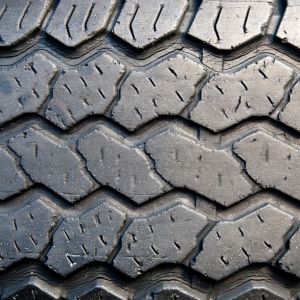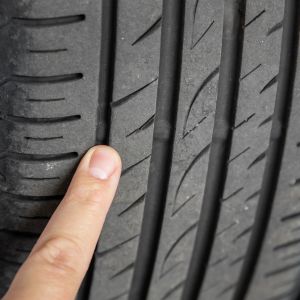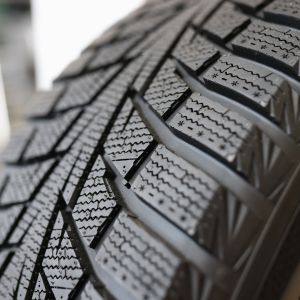The tread on your tyres is critical for both driving performance and safety. It grips the road surface, allowing your vehicle to move forward and stay on the road in slick conditions. In rainy conditions, it also channels water out from under your tyres to keep you from hydroplaning.
The tyre tread depth is the amount of tread on a tyre measured in millimetres or 32 of an inch. The depth of the grooves in a tyre’s tread pattern. Tread depth is an important factor that determines a tire’s ability to provide traction and displacement of water from the road surface; this improves vehicle safety on wet roads.
4/32 inch or greater tyre tread depth is ideal. Maintaining the tyre tread depth is critical if you want to avoid punctures. To determine the proper tread depth for your specific tyres, consult the vehicle owner’s manual or the tyre manufacturer’s recommendations.
The Function of Tyre Tread Depth

Tyre tread depth is important for the following reasons:
- Tyre tread depth is important in preventing punctures because it creates a strong barrier between the road and the tyre’s inner lining.
- The deeper the tread, the more friction there will be between the tyre’s rubber and the road. It aids in the even distribution of the vehicle’s weight and reduces the likelihood of a puncture.
- The tread on a tyre also helps to displace water away from the tyre, lowering the risk of a puncture caused by a sharp object on the road.
The adverse effect of not maintaining the tyre tread

- Uneven tread wear can indicate problems with your vehicle’s alignment or suspension and should be checked by a professional.
- Regularly checking and maintaining the proper tread depth can help to ensure passenger and vehicle safety, extend tyre life, and increase fuel efficiency. The following are the consequences of failing to maintain tyre tread:
- The tread on a tyre wears down, making it less effective at preventing punctures and increasing the risk of a puncture. As a result, it is preferable to have the tread repaired as soon as a problem arises..
- It is critical to check and maintain the tread depth of your tyres on a regular basis to ensure that they can protect the wheel from punctures and other damage.
- It is recommended that tyres with a tread depth decline of less than 1.6 mm be replaced. Because using worn tread increases the risk of an accident.
Checking the tyre tread depth
Here’s how to check the tread depth of your tyres step by step:
- Examine your tyres for the tread wear indicator (TWI). The tread wear indicator (TWI) is a small bar-like projection located in the tread grooves. It indicates that the tread depth has reached the legal minimum.
- To determine the depth of the tread, use a tread depth gauge or a coin. Insert the gauge or coin into the tread grooves and take depth measurements at several points around the tyre, including the centre and both sides.
- Compare the tread depth readings to the legal minimum. It varies from country to country and manufacturer to manufacturer.
- If the tread depth is less than the legal minimum or the manufacturer’s recommended level, the tyre will fail.
When to use tyre tread depth?

When we drive a car, we use the tread depth. It is critical to ensure that this is sufficient in all four tyres of the vehicle. It ensures proper traction and stability between the road and the tyre.
The tyre tread protects against car punctures and other types of damage that could occur if the correct tyre tread depth is not maintained. It is recommended that tyre tread depth be checked on a regular basis, especially before long trips or during changing weather.
To ensure safety and proper performance, tyres should be replaced if the tread depth is less than 1.6 mm.
Additionally, your tyres should be rotated and balanced every 6,000 to 8,000 miles, or as recommended by the manufacturer. This will help to extend the life of your tyres and ensure that the tread wears evenly, preventing uneven wear and lowering the risk of a puncture.
The best-recommended tyre tread depth
The best-recommended tyre tread depth is 4/32 of an inch or higher. However, in the United States, the legal minimum is 2/32 of an inch. It should be noted that the recommended tread depth varies depending on the manufacturer and type of tyre.
To determine the proper tread depth for your specific tyres, consult the vehicle owner’s manual or the tyre manufacturer’s recommendations. Additionally, it is critical to check the tread depth of your tyres on a regular basis and replace them if it falls below the recommended level.
Frequently Asked Questions
Q1. How important is tread depth on a tyre?
Ans: Tread gives the tyre traction and the ability to grip the road properly, even in wet conditions. The tread depth is responsible for the smooth operation of the tyres.
Q2. What is purpose of the tyre tread?
Ans: To prevent punctures, the tyre tread forms a barrier between the road and the inner lining of the tyre. It provides the tyre with the necessary traction on the road.
Q3. What is a safe tyre tread depth?
Ans: Tread depth of at least 2/32 of an inch is considered safe, but some experts recommend a minimum of 4/32 of an inch for optimal safety.
Q4. How do you check tyre tread depth?
Ans: The tread depth of a tyre can be measured using a tread depth gauge or the “coin test.” To determine the depth of the tread, use a tread depth gauge or a coin. Insert the gauge or coin into the tread grooves and measure the depth at various points around the tyre, including the centre and both sides.
Q5. What is the best tread depth?
Ans: 4/32 inch or greater tyre tread depth is ideal. The recommended tread depth varies depending on the tyre manufacturer and type.

